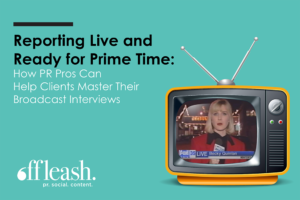Reporting Live and Ready for Prime Time: How PR Pros Can Help Clients Master Their Broadcast Interviews

It’s been called “the greatest case of mistaken identity on live TV.”
About 15 years ago, a man named Guy Goma walked into the BBC to interview for a job in IT data support. Minutes later, he was ushered into a room, seated, and wired with a microphone in front of TV cameras. Goma thought this was part of the job interview process and played along.
Suddenly he was on live TV, introduced as “Guy Kewney,” a British tech expert. Goma realized BBC producers had the wrong “Guy.” The host then asked Goma various questions about music downloads. Goma, now live on BBC News and not wanting to make a scene, tackled the questions with grace. He even predicted how people would listen to music online in the future. Meanwhile, Guy Kewney was in an adjacent room still waiting to be called to the set.
Guy Goma became an internet legend. Why? He didn’t freak out when he found himself on the air being watched by millions. Also, he did a decent job fielding questions about an unfamiliar (to him) topic. (You can watch the interview here.) Guy Goma reminds us that in broadcast, the show must go on (literally) and that with live news, one must expect the unexpected.
When it comes to securing broadcast coverage for clients, unlike Guy Goma, we have the luxury of time for at least some preparation. Here are five best practices to keep in mind when pitching, securing, and preparing for client broadcast interviews.
1. Pitch producers a complete, packaged story.
Whether you’re targeting CNBC, Cheddar News, CNN, or Bloomberg TV, remember that producers are slammed. The easier you can make their job, the better. When you pitch a producer, guest booker, or assignment editor, include all the elements of a story: the who, what, when, where, and why they should care.
For funding news, include not only the basics of the newest round, but stats about market growth, a bio of your client source, a descriptor of what the company does, company profile basics (HQ location, year founded, investors), and market competitors as well. This info will likely be pulled into bullet points for on-air graphics. Think about visuals too, as these can be played during the segment. Send a link to client product demo b-roll or footage of customers using the product. Offer a complete “package story” to a producer and they are more likely to say yes.
2. Answer the “why now?” question in your pitch.
Broadcast news can change on a dime. During my years as a TV anchor and reporter, I was often dispatched to cover a planned evergreen story only to be re-routed to a breaking news story 10 minutes later. Timeliness is everything in broadcast. TV producers are seeking the “breaking news” or “why now?” angle to any story.
Can you tie your client’s news to a particular date or anniversary? Can you localize a national story? Is there a court case your client can offer unique commentary on? Can your client offer a contrarian view to a new piece of research? Outline this in your pitch.
3. Make sure you and your client do your homework.
As an expert source, your client should seek to deliver information and educate viewers. The client spokesperson should be able to articulate what the company does (in non-jargon terms) as well as the market need/problem the client is addressing with their technology. In fact, these were the very questions our clients Scratchpad, UserTesting, and ClickUp were asked during interviews with Cheddar News and Ameritrade Network.
Provide your client details about the show segment, the purpose of the interview, and the audience. Highlight key messages along with numbers, stats, and customer examples in bullet point format. Ask your client to review briefing materials at least 24 hours before the interview and again right before the interview. Also, ask your interviewee to read the breaking news of the day. The host may at some point during the segment ask your client’s opinion/reaction to a court ruling, acquisition, market development, or the ongoing pandemic.
4. Provide a brief “broadcast 101” coaching session to your client.
Do a 30-minute practice run. During this session you can go over broadcast basics, including guidelines, tips, and tricks for using numbers, analogies, and stories to illustrate a point; speaking in 10-second (or less) sound bites; employing bridging and flagging techniques; using vocal variety; as well as broadcast logistics (what to wear, lighting, background for video interviews).
5. Be ready for the most important TV interview question.
Many broadcast hosts, anchors, and reporters always end their interview with an important question: “Is there anything else you’d like to add?” Some interviewees may dismiss this as a filler question, but it’s a prime opportunity for your client to reiterate a message or underscore an important point. The answer is never “no.” Always have a memorable anecdote, number, or message ready for this all-important question. How you answer is how the viewer will remember you, your company, and your message.
Summary
Broadcast news always has an element of unpredictability and with live TV, anything can happen. While it’s unlikely you will find yourself on the air “by accident” like Guy Goma, remember that you can’t control all the variables. Instead, focus on what you can control. Shape the story by providing a complete pitch with data, sources, and resources to producers. You can outline key messages, numbers, and sample questions to your client. You can even play “reporter” and conduct a practice interview with your client. This is how you prepare your client to deliver an effective, memorable, and compelling interview when the red light is on and the camera is rolling.